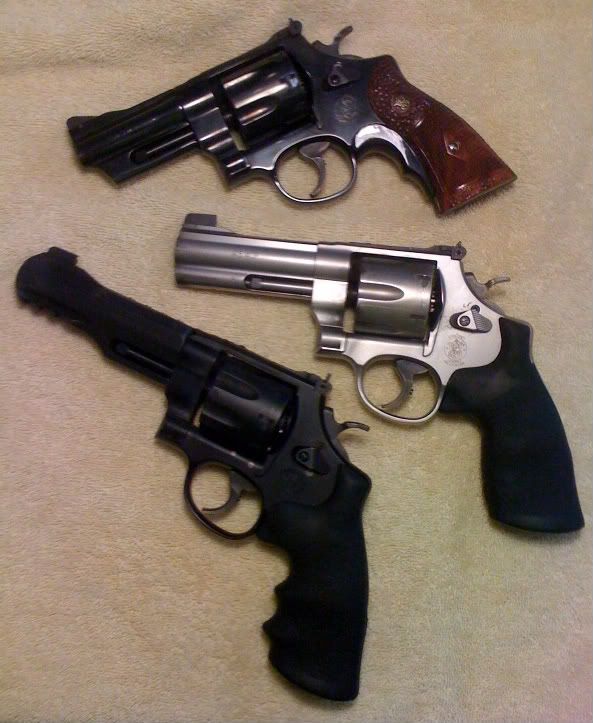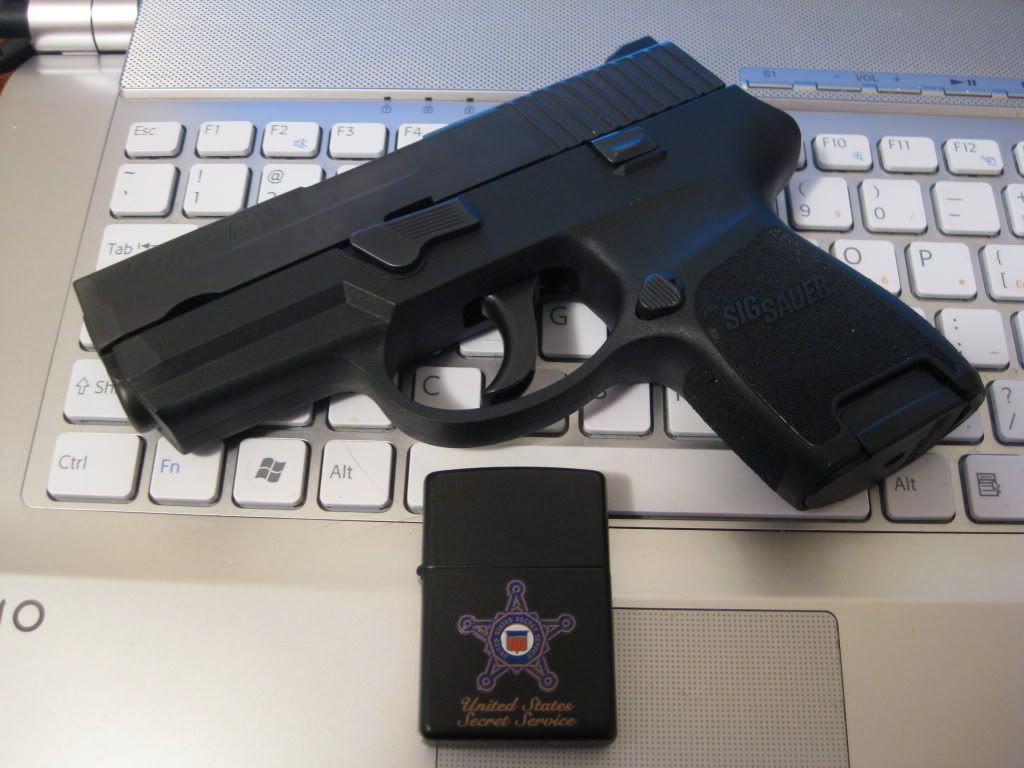Nosrac
Regular Member
A couple of 'beater' G17's are a wonderful thing to have around the house...
That would be my dad. I had to be different so I have a beater XD's for a truck guns.
A couple of 'beater' G17's are a wonderful thing to have around the house...
Using this logic we should all be jacking up our cars and leaving them on blocks when we aren't using them. After all, aren't they loaded all the time?
Again, if the limit of elasticity (modulus) has not been exceeded there will be no damage to the spring. The effect you describe migh occur but you will never live long enough to see it. It will take many, many, years before any loss of spring pressure occurs.
Dirty magazines cause far more malfunctions than springs in magazines left loaded.
The probability of a spring being made that is flawed is my concern, as I stated. If a spring is not required, ie a revolver, it simplifies the system and therefore tends to increase reliability. The act of manufacturing springs opens them up to the potential of being flawed, and therefore failing before their peers. This is my reasoning for a revolver in the circumstances I am likely to have it in.
As far as jacking up our cars to save springs and leaving them on blocks, that wouldn't help your springs at all because the same force is still exerted on them to hold the weight of the car up. I have a crappy civic, that I've driven for years and have never exceeded the maximum load in it, yet it sits with a slight lean from my fat butt sitting in the drivers seat for years on end. I could go on and on with examples of vehicular springs showing a loss in their ability to do what they originally were designed, simply by a constant load being placed on them for years. anybody who has had an fj40 land cruiser can testify to the "land cruiser lean", lol. Don't take this part too seriously, just having some fun at your example.:lol:
Shot a S&W airweight .38 snub this weekend, hammer-less, and it was awesome. I also tried out the coat-pocket feel (Dickies mechanics jacket) and it fit perfectly. Might be my next purchase.
Mindset is the single most important aspect to successful self-defense. There was a recent article on Keep and Bear Arms where a young girl (age 10-13 or so) pointed her 22 rifle at a home invader. That's mindset!
However, I want to differentiate between mindset and mastering the tool.
I put my money where my mouth was. I took revolvers to FPF Training's "Concealed Carry for Self-Defense" course. This is a two day course about mindset, tactics, and shooting. I attend this course annually as part of my "Back to Basics Refresher" because it includes a four hour multimedia presentation and covers running the gun.
I attended the course with an S&W 625 (6 shot 45 ACP), S&W 627 TRR8 (8 shot 357 Magnum) and a new S&W Model 27 (8 shot 357 Magnum). I had two modes of reloading: moonclips and eight shot speedloaders (both for the 357s, moonclips only for the 625). The 625 had the best trigger: S&W did very nice trigger work on it.

625 with hacked Hogues...seems to work fairly well too.
I spent quite a bit of time preparing for this course. Over the course of a year, I dry fired for many hours...tens of thousands of television crimes were stopped by my 625 and Model 27! I used my 22 revolver to learn how to do fairly rapid fire (using Ed McGivern's book, of all things...but it worked). I practiced reloading my guns with moonclips and speedloaders. I did some movement drills (not many though) and figured out point shooting (sub-1/2" groups with the 22 at 20 feet!). This was at the height of the Obama Ammo Panic, so I did NOT fire many 45 ACP and 357 Magnum rounds...probably 500 total.
Repairs over that year or so had to be made. I went through two S&W firing pins, which shattered during firing. Bullets jumped crimp and I lodged one round in the barrel of my 625 (bad reload, totally my fault).
Walking into that course, I was fairly confident shooting this course would not be too difficult. I felt that I would just be polishing my skills on running the gun. I was very, very wrong!
The recoil pattern of the revolver is quite different. Combine that with the long, heavy trigger and double taps were more like shortened controlled pairs. Three round bursts were difficult to do and maintain a 4" group. Zippers chewed through an entire cylinder, forcing me into the slow reload process.
Reloading the revolver is a complicated process. It's very easy to make a mistake operating at speed. The eight round moon clips were difficult to eject; I had to really hit the ejector rod to get the spent clip and cases to clear. The eight shot moonclips were more difficult to insert; the six shot 45 ACP clips were much easier to deal with.
Heat was another issue. Twenty four rounds and that forcing cone was hot! At 48 rounds, the gun was toasty and I had to wear an undershirt to avoid burning myself when holstering. Gloves became a necessity in the training environment. If you ever attend a gun course with a revolver, take at least two guns! One can cool while you shoot the next relay.
There were no jams with any of the three revolvers I used. Even though the ammunition was dirty, the guns were in top shape going into the course. My primary concern was with a bullet jumping crimp, but there were no issues with the Georgia Arms ammunition I used.

Negative Target Drill. The single action revolver DOMINATED this target. Single shots, one through each hole.
In the end, I ended up selling all my revolvers except for the S&W K18. The limited capacity of the cylinder does not lend itself well to double taps, "hearts-n-minds" and zippers. Rapid fire requires increased discipline on the part of the shooter. It is not something a casual shooter will be able to easily achieve. I was generally getting one to two inch pairs with a flyer or two (depending upon the size of the burst). More practice with full recoil loads would have solved this problem, of course. Finally, reloading the revolver, even with a moonclip, is difficult. Doing so on the move is even more difficult and I flubbed those frequently due to incorrect practice with Snap-Caps (Snap-Caps don't cut it for practice--use FMJ dummies. Snap-Caps are a bit small and "flow" into the cylinder too easily).

Rapid fire was difficult. Discipline is required. You can see where I was clustering shots around the center of the circle and at the hollow of the throat.
In the end, the basic operation of the revolver is easier. "Basic" means slow loading and unloading and firing slowly with deliberation. Operating a revolver in modern context; however, is far more difficult than operating a semi-automatic. Shooters will have to dedicate more time and money to mastering the skills required to proficiently run a revolver.

Messing up again
**
If someone were to come to me to ask for advice on which revolver to get, I'd definitely tell them to get a gun chambered in 45 ACP with a four inch barrel (three inches would be the minimum). It's easier to reload than 357 Magnum and one can do so faster. If they insisted upon getting a gun in 357 Magnum or 38 Special +P, I would then recommend they get a gun with a six shot cylinder and a four inch barrel. The eight shoot moonclips can be difficult to use at speed.
Revolver stocks are very, very important. I tried a wide variety of them. In the end, Ahrends Tactical Revolver stocks, or the old style coke bottles with a Tyler T-Grip, worked best. The rubber Hogue grips were marginal in that rounds would get caught on them when operating at speed. The reason the Ahrends grips functioned well was because 1) I dimpled the grips with a dremel and refinished them, and 2) Ahrends is cuts the stock very low to minimize the possibility of dragging while reloading. My actual preference was for checkered coke bottle grips and a Tyler T-Grip. This was the best compromise between reloading speed, grippiness, and trigger finger placement. However, the Ahrends Tactical stocks were quite good too...perhaps within 5% of the cokes/T-Grip combo. I did put hacked up Hogues onto the 625...those worked pretty well, but the T-Grip combo was better.
I would advise nobody to get a snub-nosed revolver for (I owned two over the year and a half: Ruger SP101 and S&W Model 36). They are very susceptible to flyers when firing rapid (I'm talking 12"-18" groups at 10 yards while moving laterally). Reloading is very tough and I took half a day just to figure out how to reload the SP101 somewhat quickly on the move. The best I could do from a belt mounted speed loader was five-six steps. I would only recommend the snub nosed revolver to someone if it were to be used as a BUG.
y a revolver? (just curious)

My Walther PPS is smaller...I don't need no stinkin' revolver, I have a Sig!
